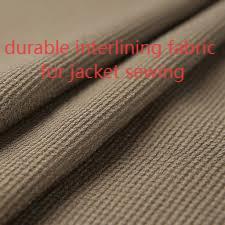In the complex world of fashion and textile production, Interlining plays a pivotal role in ensuring garments meet both aesthetic and functional expectations. By incorporating Interlining, designers can maintain shape, improve durability, and enhance the overall fit of jackets, coats, and tailored garments. This hidden layer bridges the gap between creativity and performance, allowing fabrics to drape gracefully while withstanding repeated use and wear.
1. Supporting Shape and Silhouette
A garment’s structure relies heavily on the internal support layers that reinforce collars, cuffs, and waistlines. These layers provide stability, ensuring that the garment retains its intended shape even after extensive wear. Properly integrated support materials prevent sagging and deformation, creating garments that look polished and professionally finished. This structural backing is essential for tailored clothing, formal wear, and high-end fashion items.
2. Materials and Their Functional Benefits
Support layers come in a variety of materials, each offering unique properties. Natural fibers such as cotton or linen provide softness and breathability, enhancing wearer comfort. Synthetic fibers like polyester or blends offer superior dimensional stability, resistance to shrinkage, and improved wrinkle recovery. By combining different fibers and fabrication methods, manufacturers can tailor the thickness, stiffness, and flexibility of support layers to meet specific garment needs.
3. Advanced Production Techniques
Modern textile production employs techniques that ensure consistency and quality in garment construction. Heat-fused bonding allows layers to adhere seamlessly without sewing, offering a smooth finish that maintains flexibility. Sew-in methods, on the other hand, allow more intricate designs and mobility for delicate fabrics. Precision cutting, automated pressing, and quality inspections further ensure that every garment meets rigorous standards for fit and durability.
4. Sustainable Practices in Support Layer Manufacturing
Sustainability is becoming increasingly important in the textile industry. Using recycled fibers, eco-friendly adhesives, and low-energy processing methods reduces environmental impact without compromising garment quality. Efficient resource use and waste minimization during production contribute to a more responsible and eco-conscious approach to clothing manufacturing. Consumers and designers alike are recognizing that durability and sustainability can coexist harmoniously.
5. Enhancing the Wearer Experience
The right support layers not only affect the garment’s appearance but also the comfort and confidence of the wearer. Clothing that maintains its shape and resists deformation offers ease of movement and a refined look. This careful integration of internal structure ensures garments remain functional, stylish, and enjoyable to wear over time. It also reinforces brand reputation, as consumers notice the quality and attention to detail in well-constructed apparel.
Incorporating well-designed support layers allows clothing to balance form, function, and comfort. Understanding material properties, production methods, and sustainable practices ensures that garments meet modern standards for both performance and aesthetics. For further insights on types, applications, and benefits, visit https://www.interlining-factory.com/news/what-is-interlining-types-applications-and-more.html .

